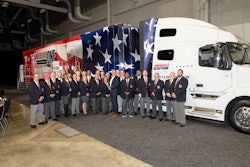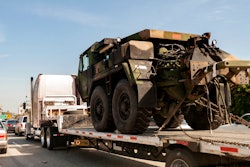The number of drivers logging long-haul mileage last year cratered, according to CCJ's 2025 What Drivers Want report, a survey of company drivers and leased owner-operators conducted in partnership with Netradyne.
The number of driver respondents to this year's query logging 125,000 to 150,000 miles dropped to just 9%, down from 16% last year. Most of those drivers seemingly moved into the 50,000- to 75,000-mile cohort, as that group jumped 4%. The group racking up more than 150,000 miles remained the same year over year (9%).
The drop in annual mileage had a corresponding impact on pay, as the number of drivers banking more than $100,000 fell by 7% and the number of drivers making $50,000 or less climbed 6%.
A slim majority (43%) expect to make the same amount of money this year, but 41% expect to make less. Only 17% expect to make more money.
Wisconsin-based leased driver Aaron Allen, among the group that expects to make less money this year, said he hopes recent licensing reforms targeting English proficiency and non-domiciled CDL holders will pull up rates and driver pay.
"Rates are tanking due to excessive capacity caused by foreign drivers and companies," agreed Missouri-based leased driver Jeff Schott, a driver for more than three decades who also expects his pay to fall this year. "There is no [financial] stability now."
More than three years of slumping rates and rising operating costs have influenced a once-common driver retention strategy: throw money at them.
 All persons registered for this webinar will receive a copy of the full 2025 What Drivers Want Report courtesy of CCJ and Netradyne
All persons registered for this webinar will receive a copy of the full 2025 What Drivers Want Report courtesy of CCJ and Netradyne
Unsurprisingly, and by a wide margin, more money is the No. 1 reason drivers said they would leave their current fleet (41%). Choice of routes and hauls is a distant second at 22%. The path to more money, according to our survey respondents is somewhat less clear. Only 6% said they would leave for more miles or loads and 0% of company drivers said they would leave for a sign-on bonus.
"Rather than more money would be just more consistency," noted leased OTR driver Lance Sloan, who's been behind the wheel for just under five years.
How drivers make their money
Most drivers (51%) reported receiving bonuses for clean inspections and safe miles driven (35%). Bonuses for fuel efficiency (14%), on-time delivery (13%), and safe driver scoring (13%) were far less common.
Pay per mile continues to be the predominant compensation method among survey respondents (33%), with percentage pay (27%) close behind, mostly driven by the leased owner-operator group (58%). A combination of miles and hourly pay reached 16% in the company driver group.
REGISTER HERE for the full 2025 What Drivers Want Report
A majority (60%) of company drivers note being paid for all miles, including deadhead. Just 41% of leased owner-operators have that arrangement, but that is still the majority of that group. The next most common method among leased drivers is short miles (27%), where pay is almost always less than actual miles driven. That also holds the No. 2 spot with company drivers at 23%.
Interestingly enough, how drivers prefer to be paid is fairly evenly split among three options: hourly (26%), a combination of hours and miles (24%), and percentage-based pay (22%). Company drivers (35%) have the strongest preference for hourly wages compared to just 7% among leased drivers. Leased drivers overwhelmingly prefer their current arrangement of percentage-based pay (48%). Combination pay was second among this group, getting just 15% of the vote.
Fighting for pay
Just under one-third (31%) of survey respondents reported having a pay discrepancy with their fleet this year, with 18% claiming it's happened more than once. Nearly half (43%) of drivers who felt shorted on pay said the issue was never resolved, and they gave up pursuing it. Of note, 14% of leased owner operators said their pay dispute turned out to be a misunderstanding, and they were actually paid correctly. Far fewer (just 3%) of company drivers noted this outcome, as company drivers made up the lion's share of drivers who simply gave up.













